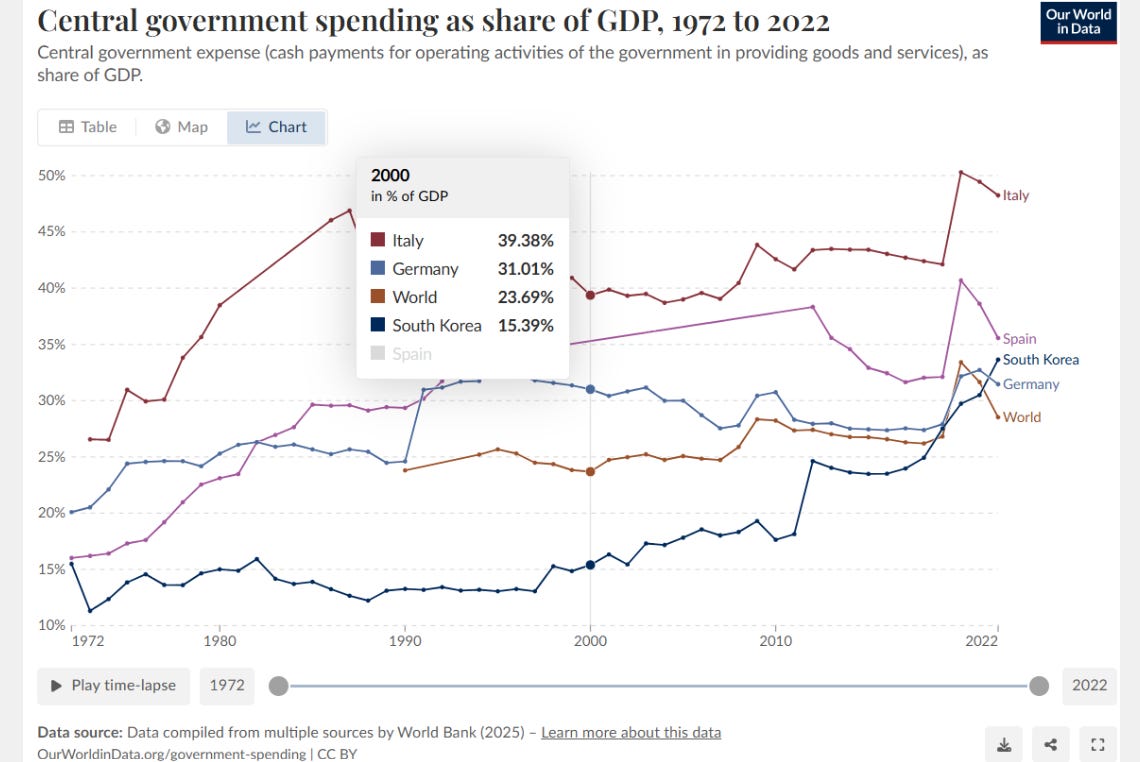One of the fantasies of elite technocrats is to cut down the size of the population and increase the size and scope of the government, putting government into the position of picking the winners and the losers of society. Like all those who argue for “planning” in contrast to “free markets” — they expect themselves to be the planners.
Back in 2000, the world had reached a sustainable limit of central government allocation of scarce resources, when the average share of all resources allocated by the central government approached 24% of GDP:
To estimate the sustainable limit of how much it is that central governments can control, but without society moving backward, you can use a percolation model, like this one designed for modeling forest fire extent — based on the share of area with combustible (fire-sustaining) material in it:
[click image to enlarge]
When only 49% of area is “useful” (combustible), a forest fire automatically burns itself out (every time). The tiny black parts at left represent where it stopped. It stopped because not enough material was fire-sustaining. The stopped fire represents a stalled economy.
When you increase the useful (combustible) material up to 71% of area, then the fire burns all the way through the forest:
[click image to enlarge]
By making it all the way to the right side of the screen, this run through the simulation reveals a successful amount of useful (combustible) material. In economies, private sector innovation is growth-sustaining, but only if enough resources are left in the private sector, rather than being allocated by the public sector (the government).
If GDP were at a value of 100, but 20% of GDP was comprised by government spending, then 80% would be left in the private sector, but there is another layer to it. Because all money government spends comes from private sector productivity, the 20% must be compared to the 80%, meaning that only 75% of private product remains:
As the second simulation shows, this amount of private sector product remaining inside the private sector (75% of what is produced there) will be enough private sector allocation of resources to sustain an economy, because even 71% would have been enough. But we’re getting close to the limit of government spending:
At the left end of this graph you can see the level that is sure to tank an entire economy (when just 49% of what is produced in the private sector remains there), and you can see an amount almost-guaranteed to sustain growth in an economy (71% of private sector product not siphoned away by an overbearing government).
In 2000, when the world average of government allocation of resources was almost 24%, then 68% of private sector product remains in the private sector (4th vertical line in from the right side of the graph above). But between governments at 24% of GDP and those at 30% of GDP, an abrupt decrease in sustainability occurs.
Check out these countries:
And now check them out in 2022:
It looks like the fires are going to burn themselves all of the way out (too much central allocation of resources). With the exception of South Korea (64% of private product remains in private sector to be allocated by private actors), the other 5 countries have centralized their economies beyond the limits of sustainability.
Evidence of the unsustainability shows up in fertility rates, which have many causes but one cause is an inability to improve in the affordability of a living standard (because of too much central allocation of resources):
By about 1990, fertility rates (# of children per woman) were below “replacement rates” (2.1 kids per woman) in places having high central allocation of resources (low economic freedom). This outcome (shrinking populations) is actually what the elite technocrats wanted all along. Let’s fight such hyper-centralization tooth-n-nail.
Reference
[Fire model from the Earth Science section] — https://ccl.northwestern.edu/netlogo/models/index.cgi










